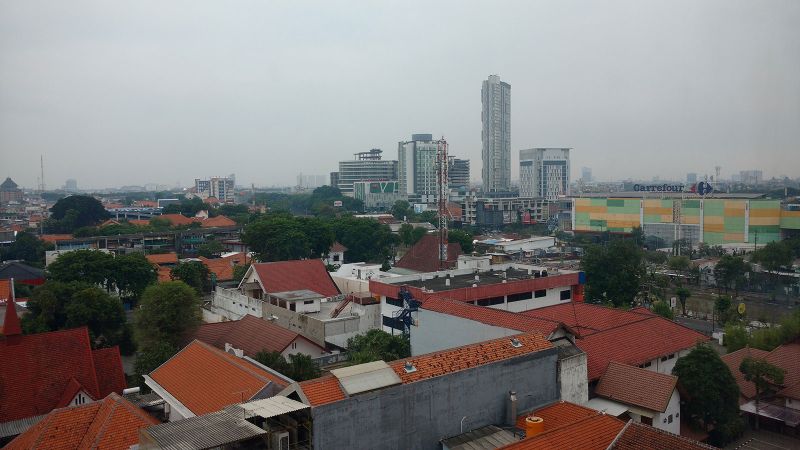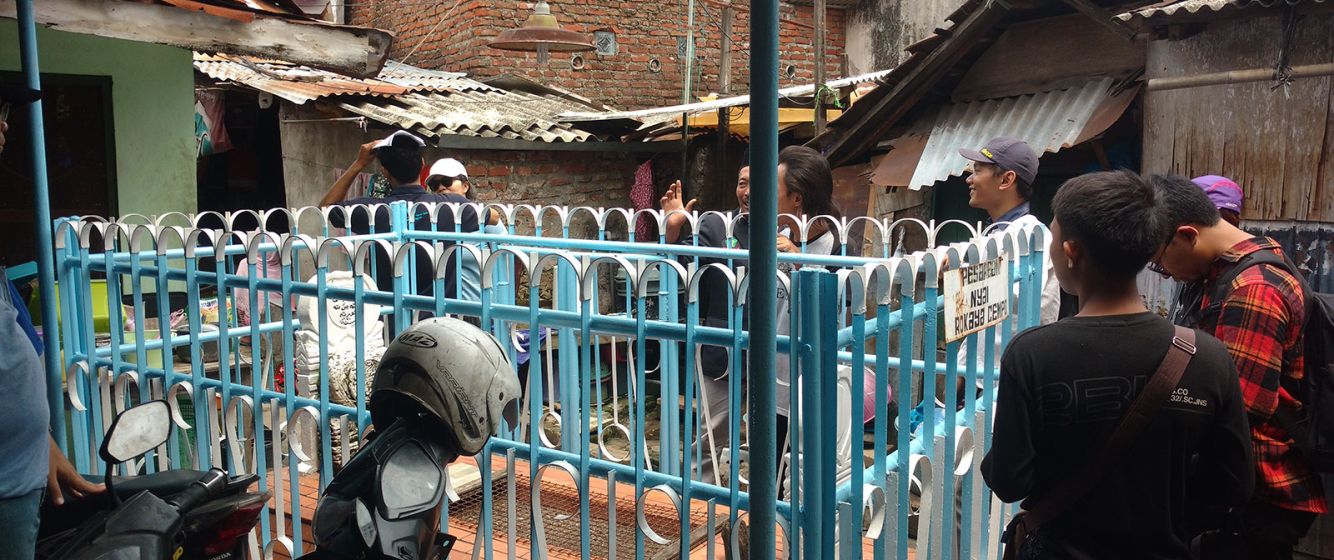Instead of going to our hotel, we head straight from Surabaya airport to kampung Peneleh. At the kampung, we disembark at the house of Hadji Oemar Said Tjokroaminoto, an Indonesian nationalist.
By Cheryl Jacob
Tjokroaminoto was the leader of Sarekat Islam, a traders’ co-operative that developed into a wider political movement. From his home in Peneleh, Tjokroaminoto operated a boarding house of sorts that doubled as a political school. And from this boarding house, emerged three prominent Indonesian figures – Sukarno, a nationalist and Indonesia’s first President, Semaun, first chairman of the Communist Party of Indonesia, and Kartosoewirjo, the radical Islamist rebel leader. This is our first glimpse of the diversity of Peneleh.
Kampung Peneleh
It’s noon and it’s hot. The Kalimas river, one of the reasons for our presence, is just out of sight. It is the 13th of December 2017. The River Cities symposium organized by the Universitas Airlangga and the International Institute for Asian Studies has just finished. The group standing outside Tjokroaminoto’s house is a mixed bunch, including the symposium’s participants and organizers, UKNA members, SEANNET researchers and representatives of the Indonesian department of tourism. We split into two groups and explore Peneleh. As a kampung, Peneleh is a sort of village inside the city of Surabaya. It’s the research site for the Surabaya team of the South East Asian Neighbourhood Network (SEANNET). Adrian Perkasa, from the history department of the Universitas Airlangga, generously acts as our guide and translator. He leads us down the narrow streets and by-ways of the kampung to the grave of a relative to Sunan Ampel, a fifteenth century saint revered for bringing Islam to Indonesia. Blue metal railing surrounds the gravestone, separating it from the homes that overlook it on all sides. While the gravestone is technically a monument, it’s clear that we’re also in someone’s backyard or frontyard, these words having very little meaning in the urban setting that we are in. Then, we head towards a colonial Dutch cemetery built in 1814. A vast open space, the cemetery sticks out in the tightly-packed kampung. Its tombstones bear Dutch names alongside those of the English, French, Armenian and Japanese. Some of the more elaborate graves have roofs and statues. There are number of angels leaning wearily against crosses, many with their heads chopped off. In one corner, there’s the grave of a former governor-general of Surabaya, Pieter Merkus. Close to him lies Onnes Kurkdjian, an Armenian photographer employed by Queen Wilhelmina. Now, children play football and couples take pre-wedding snaps here, knowingly and unknowingly rubbing shoulders with history.

A view of Surabaya, Indonesia (December, 2017)
SEANNET Roundtable
It’s this idea of how people see their own neighbourhoods that underlies the work of the Surabaya team. The next morning, safely ensconced in the hotel’s air-conditioning, the members of SEANNET sat down for their roundtable. As the hosts, the Surabaya team went first. They included undergraduates and students of multiple disciplines – History, Architecture and even Sport Science. The history student, still in the middle of her studies, discussed the idea of history as past and how her engagement with the Peneleh community had shown her the relevance of history to the present. This was echoed by the architect who found a very different perspective emerging when you thought about places from the points of view of those who lived there. To unearth these hidden perspectives, the team used the social and mental mapping of space, inviting the members of each RT[1] to build their own community map. These community maps, by virtue of what they showed and what they didn’t, were a portal to an altogether different experience of the kampung. Another method deployed was a very literal unearthing of memories through an old photo competition. Residents were invited to share old photographs of the kampung with the chosen winner earning a prize. The images that were received included a charming photograph of children dressing up to celebrate Indonesian independence day and another of bare-chested workers constructing the mosque that towers both physically and spiritually over the kampung. The techniques deployed by the Surabaya team don’t fit neatly into specific disciplines but their participatory and community aspect showcase what is possible with these techniques. Despite bureaucratic challenges, the team managed to ‘think with’ the community and capture the layers of pride as well as anxieties that overlay the idea of the kampung. As Rita Padawangi of Singapore University of Social Sciences pointed out, the success of the activities flowed from the fact that they were decided with the community. Perkasa also pointed out that despite previous attempts, there is no study of the kampung in the urban history curriculum in the Universitas Airlangga. The SEANNET project includes two locations from Thailand – one in Chiang Mai and another in Bangkok. The team from Bangkok talked about their interdisciplinary field teams who collected both quantitative and qualitative reflections on their neighbourhood, Nang Leong. As a historical and populous part of the city, the area is relatively well-studied and the team hopes to bring in new perspectives by building diverse information networks and by using certain social hubs as avenues of entry into the life of the community. The team from Manilla divided their foray into the neighbourhood of Escolta into three sub-projects. The most advanced of these sub-themes was the work done with the homeless by Alma Quinto, an artist. The homeless of Escolta seem to have a mutually beneficial relationship with the store owners. They are allowed to store their belongings in the spaces around the stories and sleep in front of the shop fronts at night, acting as de facto security for the establishments. The team has so far refrained from using students for fieldwork due to the ongoing drug-related violence. The other themes being explored by the Manilla team are food culture and mapping. The team from Chiang Mai showcased their architectural data and the maps that they had built. Their neighbourhood Wua-lai is famous for its silver craft. The neighbourhood’s two Buddhist temples, the Wat Sri Suphan and the Wat Muen San, form the spiritual centre. The community has been taking steps to build a narrative of development around itself through the dissemination of audio-visual material describing the ‘Sri Suphan model’. The neighbourhood of study in Ho Chi Min city are the 13th and 14th wards, bounded by the Nhiêu lộc canal. A densely populated area, it’s home to a predominantly catholic community. The Ho Cho Minh team have completed extensive data gathering, collecting quantitative information on more than one thousand households as well as sixty in-depth interviews with residents. Mawlamyine is the most populated city in Myanmar. The Mawlamyine team has attempted to use, in their words, more democratic methods of data gathering. Themes and Issues Discussions around the presentations were sharp and cogent. Liling Huang from Taipei discussed how the projects would benefit from starting with the idea of what is worth safeguarding rather than with methodology. She talked about how, more than twenty years ago, the residents of a neighbourhood in Taipei City that had to undergo redevelopment had petitioned the government that they be trained as planners so they could participate in the process. This idea of community planners had great resonance with the idea of neighbourhoods as the entry point into cities. Paul Rabe from IIAS cautioned against the use of the word ‘community’ in a way that elided over the complexity of diverse sub-communities. Philippe Peycam and Aarti Kawlra talked about how certain projects needed to embrace more participatory techniques and to create knowledge with (and not just on) the sub-communities that they were studying. They also discussed the pedagogical innovations involved in using the kampung as a method to understand the city. Non Arkaraprasertkul from Sydney University, a part of the Bangkok team, saw themes emerging around the politics of displacement, the political economy of hope and despair, heritage and culture and development. Tessa Maria Guazon from University of Philippines saw potential in pursuing the modes of itinerancy, both of people and structures, as well as the lives on the fringes. In light of the bureaucratic difficulties that were a common experience among the team and the realities of community research, Jayde Roberts from Tasmania University found the idea of the charismatic individual who opens doors of all kinds an interesting subject.
Leaving the city
As the roundtable was wrapped up with, the rest of the agenda in Surabaya was workshops, entertainments and more opportunities for interaction with the residents of Peneleh. The vibrancy of the community’s response to the activities proposed by Surabaya team and their enthusiasm in sharing their maps were signs of what is possible in terms of co-production of knowledge. As we left the city of Surabaya, SEANNET’s hope of leaving the city behind in terms of a more ideal theoretical approach seemed to have concretized. The members of SEANNET were highlighting the flaws in the current practice of urban studies or urban history that was comfortable with the city as its unit of entry. By working on South East Asian cities, they were simultaneously engaged in knowledge production as well as methodological innovation. This is the same challenge that stands before researchers from the Humanities across Borders project as well. It also dovetails with the broader goal of HaB - to reflect on current educational practice and envision pedagogical and methodological interventions to revitalize the current model of the humanities. Officially, the smallest administrative building blocks of Surabaya are the Rukun-Warga or RW which are further subdivided into Rukun-Tetangga or RT.
